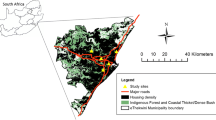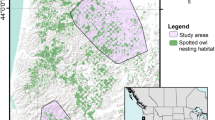Abstract
The habitats occupied by species of wood warblers (Emberizidae) were compared at two study areas, Itasca State Park, Minnesota and Mount Blue State Park, Maine. Univariate comparisons of each variable of habitat structure show geographic differences for each species of warbler. Habitats available were also different because small trees were always more dense in Maine than in Minnesota. The Black-throated Green Warbler had the most dissimilar habitat with 9 of 11 variables different at the two sites.
Cluster analysis identified four generalized habitat groups containing (1) species occupying territories with high percent shrub cover, (2) forest species from Maine, (3) forest species from Minnesota and (4) open country species. Reciprocal averaging ordination was used to identify habitat gradients at each site. The first axis of the Maine and Minnesota ordinations was a gradient from open country with dense ground cover to forest vegetation. The second axes differed, however. In Minnesota, the gradient separated medium deciduous trees from large conifers, whereas in Maine, vegetation graded from medium and large deciduous trees to coniferous habitats. Spearman rank correlation indicated that the warblers were similarly arranged along both habitat axes at each site despite differences in axis loadings of habitat variables.
A combined reciprocal averaging ordination separated forest and shrub-forest edge species in Maine from the same two species groups in Minnesota along a smaller to larger tree axis. The results clearly demonstrate that habitat structure is not consistent throughout the range of many widely distributed species. It is suggested that the similar arrangement of species along the habitat axes probably results from an individualistic distribution of opportunistic bird species. Variation is probably induced at a site level by intraspecific competition for territories, small-scale vegetation dynamics, and resource fluctuation that occurs both within and between seasons.
Similar content being viewed by others
References
Barrowclough GF, Corbin KW (1978) Genetic variation and differentiation in the Parulidae. Auk 95:691–702
Braun EL (1950) Deciduous forests of eastern North America. Blakeston Press, Philadelphia, Pa. p 596
Cody ML (1978) Habitat selection and interspecific territoriality among the sylviid warblers of England and Sweden. Ecol Monogr 48:351–396
Cody ML (1981) Habitat selection in birds: the roles ofvvegetation structure, competitors, and productivity. BioScience 31:107–112
Collins SL (1981) A comparison of nest-site and perch-site vegetation structure for seven species of warblers. Wilson Bull 93:542–547
Collins SL (1983) Geographic variation in habitat of the Blackthroated Green Warbler (Dendroica virens). Auk: in press
Collins SL, James FC, Risser PG (1982) Habitat relationships of the wood warblers (Parulidae) in northern central Minnesota. Oikos 39:50–58
Futuyma DJ, Gould F (1979) Associations of plants and insects in a deciduous forest. Ecol Monogr 49:33–50
Gauch HG (1982) Multivariate analysis in community ecology. Cambridge University Press, London. p 298
Gauch HG, Whittaker RH, Wentworth TR (1977) A comparative study of reciprocal averaging and other ordination techniques. J Ecol 65:157–174
Goff FG, West DC (1975) Canopy-understory interaction effects of forest population structure. For Sci 22:98–108
Greenberg R (1979) Body size, breeding habitat, and winter exploitation systems in Dendroica. Auk 96:756–766
Heinrich B, Collins SL (1983) Caterpillar leaf damage and the game of hide-and-seek with birds. Ecology in press
Hilden O (1965) Habitat selection in birds. Ann Zool Fenn 2:53–75
Hill MO (1973) Reciprocal averaging: an eigenvector method of ordination. J Ecol 61:237–249
Holmes RT, Robinson SK (1981) Tree species preferences of foraging insectivorous birds in a northern hardwoods forest. Oecologia (Berlin) 48:31–35
Holmes RT, Schultz JC, Nothnagel P (1979) Bird predation on forest insects: an exclosure experiment. Science 206:462–463
James FC (1971) Ordinations of habitat relationships among breeding birds. Wilson Bull 83:215–236
James FC (1978) On understanding quantitative surveys of vegetation. Amer Birds 32:18–21
James FC, Shugart HH (1970) A quantitative method of habitat description. Audubon Field Notes 24:727–736
Johnson DH (1981) The use and misuse of statistics in wildlife habitat studies. pp 11–19 In: Copen DE (ed) The use of multivariate statistics in studies of wildlife habitat. USDA For Serv Gen Tech Rep RM-87. p 249
Johnson FL, Bell DT (1975) Size class structure of three streamside forests. Amer J Bot 62:81–85
MacArthur RH (1958) Population ecology of some warblers of northeastern coniferous forests. Ecology 39:599–619
Morse DH (1980) Foraging and co-existence of spruce-woods warblers. Living Bird 18:7–25
Noon BR, Able KP (1978) A comparison of avian community structure in the northern and southern Appalachian Mountains. pp 98–118 In: DeGraaf RM, (ed) Proceedings of the Workshop Management of southern forest for nongame birds. USDA For Serv Gen Tech Rep SE-14. p 176
Noon BR, Dawson DK, Inkely DB, Robbins CS, Anderson SH (1980) Consistency in habitat preference of forest bird species. Trans No Amer Wildlife and Nat Res Conf 45:226–244
Rotenberry JT, Wiens JA (1980) Habitat structure, patchiness, and avian communities in North American steppe vegetation: a multivariate analysis. Ecology 61:1228–1250
Runkle JR (1982) Patterns of disturbance in some old-growth mesic forests of eastern North America. Ecology 63:1533–1546
Sabo SR, Whittaker RH (1979) Bird niches in a subalpine forest: an indirect ordination. Proc Nat Acad Sci 76:1338–1342
Smith KG (1977) Distribution of summer birds along a forest moisture gradient in an Ozark watershed. Ecology 58:810–819
Sneath PHA, Sokal RR (1973) Numerical taxonomy. WH Freeman Co, San Francisco, Ca. p 573
Svardson G (1949) Competition and habitat selection in birds. Oikos 1:157–174
White PS (1979) Pattern, process and natural disturbance in vegetation. Bot Rev 45:229–300
Whitmore RC (1975) Habitat ordination of breeding passerine birds of the Virgin River Valley, southwestern Utah. Wilson Bull 87:65–74
Whittaker RH (1975) Communities and ecosystems. MacMillan Co, New York, NY. p. 385
Wiens JA (1975) Avian communities, energetics, and functions in coniferous forest habitats. pp 226–265 In: Smith DR (ed) Proc Symp Manage For and Range Habitats for nongame birds. USDA For Serv Gen Tech Rep WO-1
Wiens JA (1977) On competition and variable environments. Am Sci 65:590–597
Wiens JA (1981a) Single-sample surveys of communities: are the revealed patterns real? Am Nat 117:90–98
Wiens JA (1981b) Scale problems in avian censusing. Studies in Avian Biology 6:513–521
Wiens JA, Rotenberry JT (1981) Habitat associations and community structure of birds in shrubsteppe environments. Ecol Monogr 51:21–41
Author information
Authors and Affiliations
Rights and permissions
About this article
Cite this article
Collins, S.L. Geographic variation in habitat structure for the wood warblers in Maine and Minnesota. Oecologia 59, 246–252 (1983). https://doi.org/10.1007/BF00378844
Received:
Issue Date:
DOI: https://doi.org/10.1007/BF00378844




